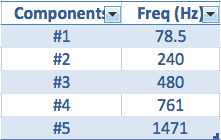Have you ever tried to measure the speed of the train which is slowing down? Measuring the frequency of the Himalayan Singing Bowl is a similar exercise. The reason – each singing bowl produces multiple frequencies and hence trying to measure one frequency and giving it a “note” is similar to applying the Newton’s law in energy healing !!
(For background, we use singing bowl in sound healing and its multiple harmonics enable brain-wave entrainment and enables the mind/body to achieve deep rest, facilitating the healing process.)
Spectrum Analysis of a Singing Bowl’s Sound
Let me share a spectrum (in simple words, the frequency spectrum indicates the amplitude of each frequency present in the sound sample). If you see the spectrum, it is clear that it has three very distinct frequences present. In fact, the pattern is just a sample since this entire pattern also moves at a specific frequency. In other words, the singing bowl produces multiple frequencies or overtones.
What is the “note” of the bowl?
It is common practice to assign a “note” to each bowl. While there is a reason by this is done, it is entirely a left brain exercise if we use that as “the only basis” to judge/select/use the bowl. For example, if we use a commonly available guitar tuner app to measure the note of the bowl (whose spectrum is shown above), it shows “A” at ~110 Hz (somewhere around the first peak shown on the spectrum). As you can see, by assigning a pitch, we are “assigning” the bowl to be dominantly creating the sound represented by the first peak (essentially ignoring that the bowl also generate at least 2 other very strong frequencies beyond 110 Hz).
Summary
In short, I hope it is clear now that assigning the note to a singing bowl is a very “vague” exercise and does not represent the real capability of the sound produced by the singing bowl. Specifically, when we are talking about the impact on the brain wave through entrainment, this “note” based representation of the bowl is misleading. In reality, the bowl has first peak at about 110 Hz, the second one at about 330 Hz and third one at about 660 Hz. To conclude, this particular bowl has a low frequency, a mid frequency and also a high frequency.
Another example for getting better perspective:
The analysis below is using a bowl that was marked note “B” when I procured it. You can clearly see at least 3 peaks (if you see the waveform in real time, the entire waveform moves up and down – indicating a very low frequency also present).
The table below captures the frequencies of the same bowl (Courtesy: WAVANAL). It is clear from both the chart (above) and the table (below) that the sound of this bowl contains multiple frequencies ! In future articles, we will learn more about these frequencies and its relationships with the sound of the bowl(s).
Hope by now it is clear that assigning a “note” (and only one “note”) to a bowl is similar to applying the Newton’s law in outer space.
Copyright © Gunjan Trivedi
(Feel free to re-use, with prior permission of the author via [email protected])
Selection of the Himalayan singing bowls
At Wellness Space, we also have bowls available for purchase, though it is offered primarily to our workshop participants. Our workshop includes a section on how to understand the frequency of the singing bowls and the key principles to watch out while selecting the bowls. It is important to realize that identifying a bowl is more than just a numbers game.
As captured above, we do not recommend a bowl for a specific chakra. That is a myth and given that each bowl has multiple frequencies it is possible to use each bowl across different chakra. Moreover, while we all have capability and tools to select the bowl on the basis of frequencies, we need to recognise that each individual (mind-body system) responds uniquely to sound vibrations and it is a bit naïve to assume that one frequency works for each individual. This is where it is important for us to recognize that each bowl contains multiple frequencies and the intensity or amplitude of that frequency varies based on how we strike the bowl!
Inquire about the singing bowls:
We usually recommend a set of 4 or set of 7 singing bowls. Set of 4 bowls come in the diameter range of about 17 to 24cm. Set of 7 bowls cover the range from 17cm upto 27-28cm. You can write to [email protected] or send whatsapp at +91.90998.53884
You can also read another article related to Chakra Singing Bowl
Chakra Singing Bowl set? Math? or Myth? – A perspective
Following links provide more information about the work we do:
- Naad Yoga (Sound healing) workshops
- Understanding the frequencies of the singing bowl
- One bowl for each chakra – a real need or a myth?
- Our research with singing bowls, meditation and more – click here
- What is Society for Energy & Emotions – that certifies our workshop contents?
Please contact me if you have any feedback on these ideas.
Gunjan Y Trivedi











